"The Huangpu Anchorage"
- - about 1850 - -
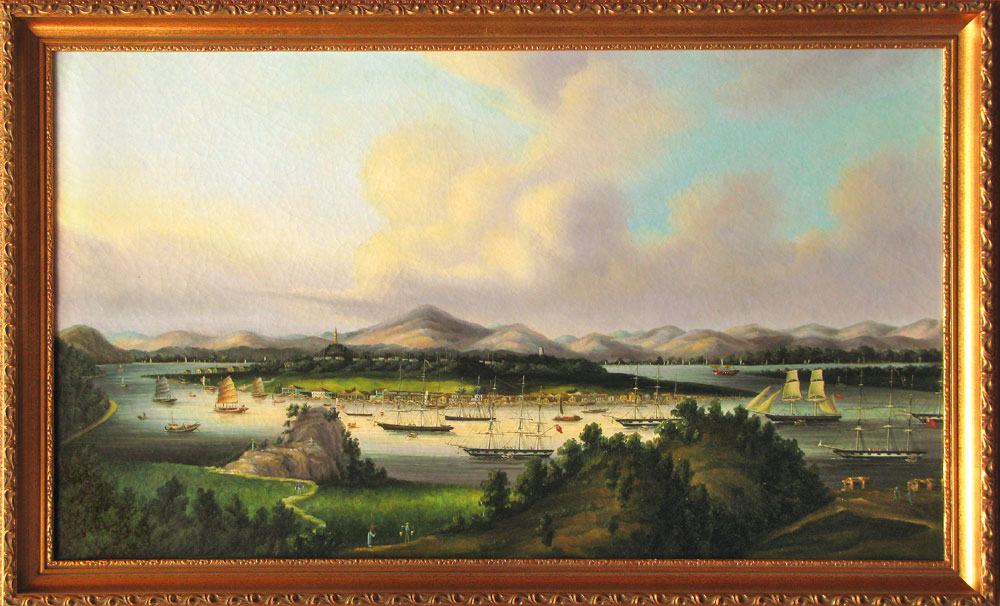
Danes Island
My cleverly made copy of a
well known painting from the Hong Kong Museum of Art.
(From the private collection of the web master)
CHINA
- In search of "The Lost Graves" on Danes Island -
As earlier mentioned in the
section on "The China Trade" , I have a cleverly made copy of an old painting
showing the anchorage at Huangpu (Whampoa) Reach, as it appeared about
1850.
The view is from Danes Island,
in the Pearl River.
Huangpu (Whampoa) Island with
its pagoda can be seen in the background, and all the European ships are
seen at the anchorage between Huangpu Island and Danes Island, - an area
referred to as English Reach.
In the background, - to the
right of the pagoda -, is White Cloud mountain.
The waterway to the left of
Whampoa Island is Fiddlers Reach, and to the right of the island you see
Junk River and a part of Junk Island.
In the lower part of the left
side of the painting is the inlet to French Reach, - just visible
-, and also showing a small part of French Island - - -
Behind it all is the Whampoa
Channel leading up to Canton and Shamian Island - - -
The original painting is now
kept in the Hong Kong Museum of Art.
And that painting really got
me going - - - - -
"The Huangpu Anchorage"
- - about 1850 - -

Danes Island
My cleverly made copy of a
well known painting from the Hong Kong Museum of Art.
(From the private collection of the web master)
"Danes Island" - - - ?????
Why was it called so????
Did Denmark posses a colony
in China?????
And what did all the ships
do there????
There did not seem to be any
town at all!
What was the story behind that
painting????
Where exactly is "Danes Island"????
What does it look like today???
A detail on the picture clearly
shows a hill near the bank of the Pearl River, where a cross and stones
can be seen!
A cemetery,- and obviously
a Western one -, because the Chinese do not use the cross as tomb decoration!
Who were buried there, and
is it still possible to find the remains to-day????
The questions were many, and
I had no answers - - - -
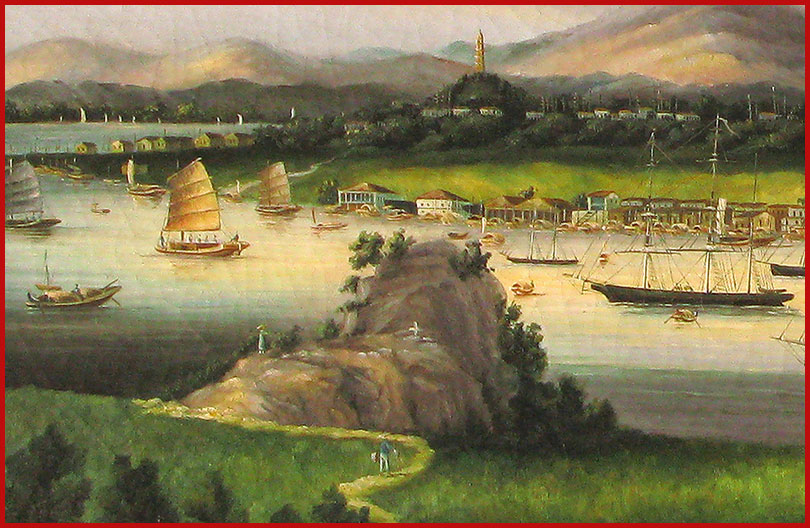
Danes Island
Detail showing Cemetery Hill
on Danes Island,- and Huangpu with pagoda -
(From the private collection of the web master)
I really got a very strong urge
to find the answers, and to visit the very same spot the Chinese artist
had used as viewpoint, when he painted the picture for more than 150 years
ago - - -
And ,- if possible -, I would
try to find the remains of the European sailor's graves which are shown
on the painting.
To mention my own ancestors,-
the Danes have been sailing to the Far east since 1673, and it is believed,
that about 2000 Danish sailors died during the China trade, and are buried
there,- somewhere - - - -
I wanted to find the remains
of those European sailors who did not make it back again - - -
But I had several problems -
- - -
First of all,- which one of
the numerous islands in the Pearl River delta is Danes Island?????
The modern charts covering the
Pearl River delta showed no island known under that name, and likewise
the modern pilot books that any oceangoing ship carries, also did not mention
any such island!
But I had good luck - - - -
Because now and then, the pilot
books are replaced with new editions, and the old books are usually just
thrown overboard or incinerated!
Except when I am around, because
I collect them - - - -
The old editions of those books
are true treasure houses of information, - and also works of art-, with
a lot of drawings made by the early navigators, who first explored those
waters, and paved the way for those who followed!
The new pilot books have no
artistic and beautiful drawings, but only photographs - - - -
But in my old China Sea Pilot,-
Volume 1, Fourth Edition, from 1978-, I finally struck gold - -
In the description on the channels
leading up to Guangzhou, the island Chang Zhou is mentioned, and in a parenthesis
after the name is writen: "Danes Island"!!!!
Without any doubt,- Chang Zhou
was my island,- - - - Danes Island!!!!
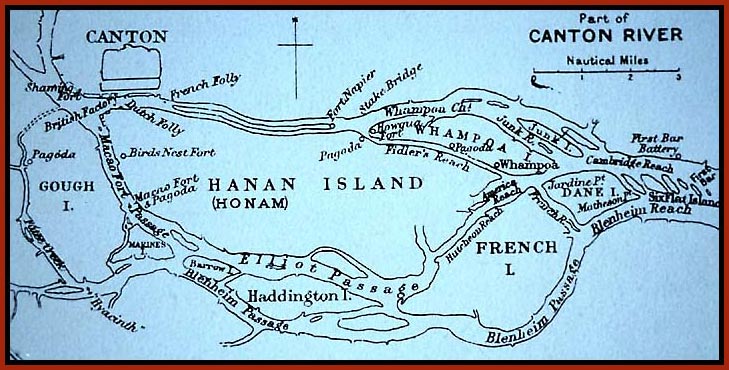
Old map clearly showing "Danes
Island" to the right - -
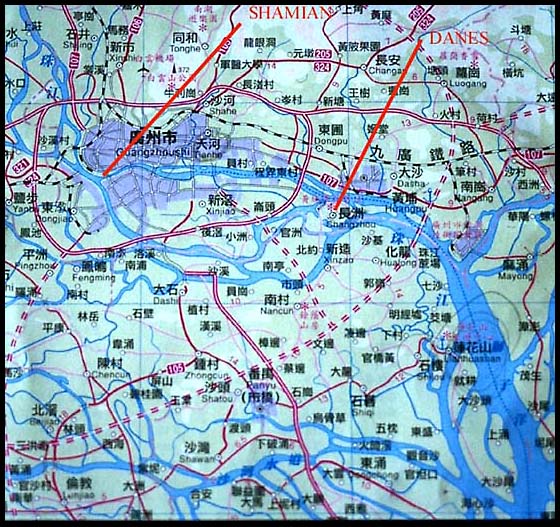
Modern map showing the same
area,- with marked positions of Danes
Island,- where the Western
ships were anchored, and the sailors were
buried -, and also Shamian
Island, where the actual trade took place.
But the description in the pilot book also gave some very disturbing information: "Military and naval establishments are situated on Chang Zhou." !!!!!
Military area?
Maybe the island was closed
area to adventurous travelers like me????
There was only one way to find
out!
Go and see for myself, and
see what I could do about it!
After a couple of years dreaming
and planning, the day finally came when the search for "The Lost Graves"
began.
It was Saturday 19th. of January,
2002 - - -

The "Pearl River" as seen through
a water stained ferry window.
- between Hong Kong to Guangzhou,
- in mist, - and with heavy traffic -
(Photography by Karsten Petersen)
I realized, that on a small island far away from the tourist trail, I would need an interpreter since a lot of discussions with authorities might be required.
The obvious choice was Kit Yu,
who later became my wife.
She lived conveniently in Guangzhou,-
near Chang Zhou island-, and had both the spirit and the drive to explore
unusual areas and things!
Immediately she was in on my Danes Island project, but due to some circumstances beyond our control, she had to be present in Hong Kong at the same time when I was proceeding in the opposite direction,- up the Pearl River on the ferry boat to Whampoa!
I had to find a stand-in for
Kit Yu, and got contact to Xiao Ling.
This was a completely new experience
to her, because this was actually the first time in her life, that she
had faced a Westerner,- a "gwei-lo" -, and even talked to him!!!
When I explained my plans to
her, she stared into my face with that typical Asian look that clearly
expressed her thoughts: "Yes,- the old folks are absolutely right
about the "Foreign Devils"!!! They really are crazy!!!"
Crazy or not,- she was very
interested in helping me -, and the next couple of days, she proved to
do extremely well - - - -
I am quite sure, that without
her I could not have done it on my own,- or at least it would have taken
me days to do what we now made in just one - - -
To show people what we looked for, I had visited a net cafe in Guangzhou, and downloaded a copy of the old painting showing the Western cemetery on Danes Island, and with that in my hand, we were on our way, in search of the forgotten graves - - - -
With Xiao Ling as a competent
guide, it was no problem to find transportation to the ferry station, and
for a ridiculous low fare, we were soon navigating the Pearl River on the
way to Danes Island, which was only a few minutes ferry ride away from
Whampoa - -
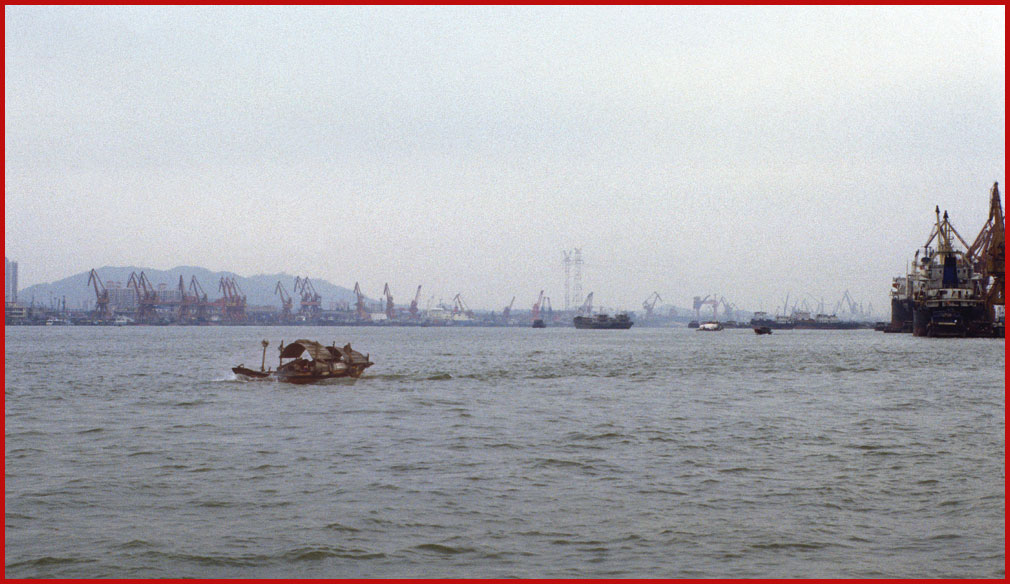
View from the local ferry to
Danes Island
- Pearl River , - and the endless
Whampoa docks in the background -
(Photography by Karsten Petersen)
But nothing looked like on the
old painting - - - - absolutely NOTHING - - - -
For a short, terrible moment
I wondered if it was the right island we approached????
Could just a little more than
150 years really change things so dramatically?????
Whampoa Island (Huangpu) was
now fully developed with buildings absolutely everywhere!
Nothing green could be seen,
and everything was shrouded in gray smog from China's millions of smoking
chimneys - - - -
And Danes Island was indeed
military area - - - -
A couple of destroyers, and
some smaller warships were moored at the island, and another destroyer
was under repair in a navy dry dock - - - -
Would I as a foreigner be allowed
on this island????
Loaded with cameras and maps????
Would I be arrested for spying
again, like I have been a couple of times before in the seventies during
the Cultural Revolution????
No,- nothing happened, and freely
I could finally walk ashore on Danes Island - - - -
As a "Gwei-lo" I did of course
create some attention, but the small town at the ferry station was like
any other small Chinese town, and no police or military people could be
seen - - -
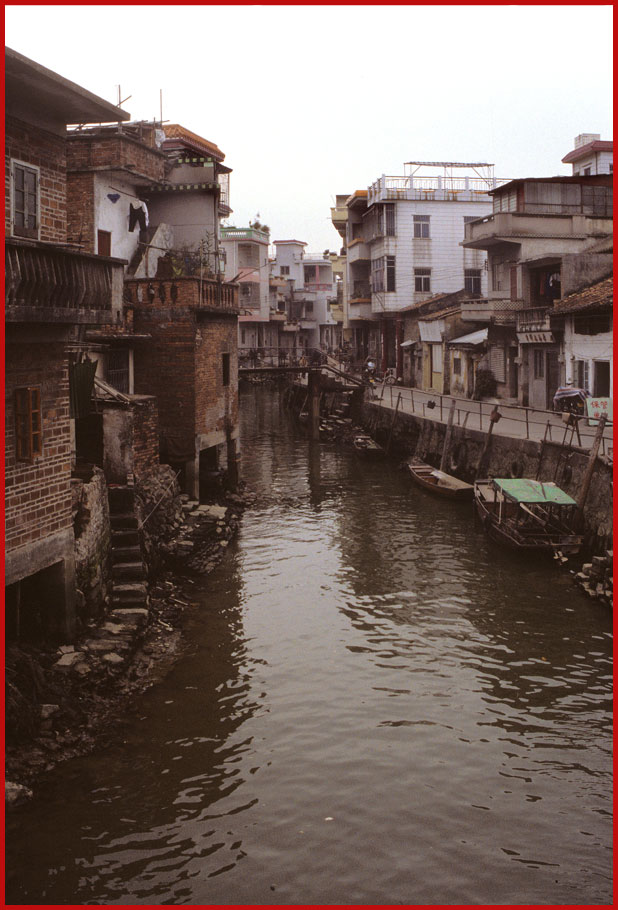
Danes Island
- view of the village and canal
near the ferry station -
(Photography by Karsten Petersen)
We needed transportation, and
some advice of where to start the search, but since the island did not
have normal taxis, we had to use motorbikes.
Just at the ferry station a
whole gang of those motorbike taxis were waiting for customers, and Xiao
Lings skill as negotiator came to the first test - - - -
She explained what we wanted,
and showed the old picture to the cabbies, and after a lot of discussions,
she chose two "bike cabbies" that appeared to know the island well - -
-
In China those motorbike taxis
are very common,- and cheap -, and it is law, that both the driver and
the passenger MUST wear a crash helmet.
Apparently that law had not
yet found its way to this small island, and without helmets we were soon
on out way, and no police officer would not even think about nailing us
for NOT using the compulsory protection- - -
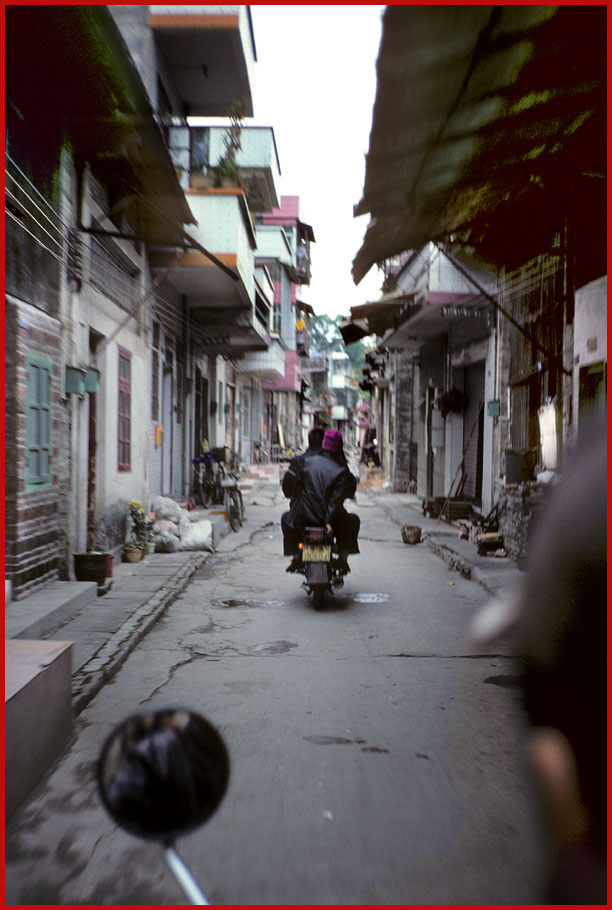
Danes Island
- on our way through
the back streets, - Xiao Ling in front -
(Photography by Karsten Petersen)
However, - my guides were not
quite sure of the location I looked for, and locals had to help with suggestions.

Danes Island
- asking direction -
(Photography by Karsten Petersen)
The first burial place we came
to was NOT the one I looked for - - - -
It was a steep hill overgrown
with trees,- and a tall monument at the top (See picture), but it
soon became obvious to me, that it was more likely a mass grave for victims
of one of Chinas many internal struggles, and not a grave site for the
first western sailors.
Also it was of a much younger
date than the cemetery I looked for.

Danes Island
My team at "new" monument,-
Xiao Ling and our guides -
(Photography by Karsten Petersen)
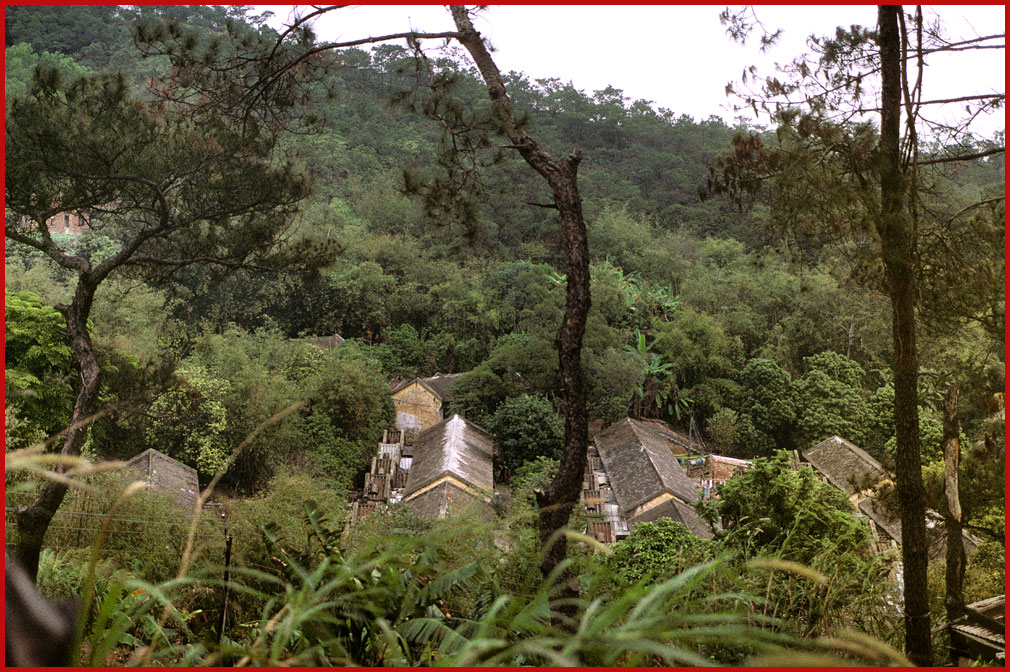
Danes Island
- village below the hill with
the monument -
(Photography by Karsten Petersen)
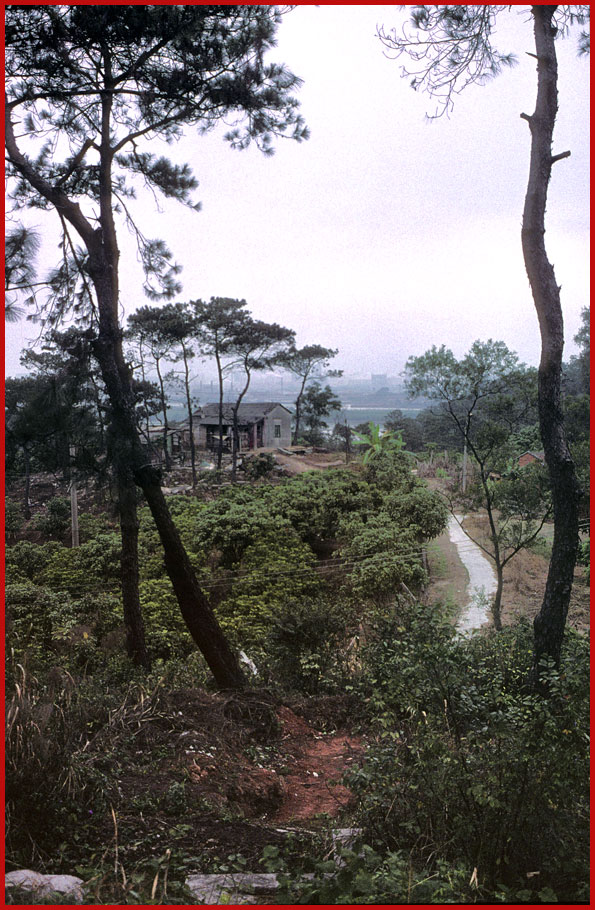
Danes Island
- here a view towards Whampoa
Island -
(Photography by Karsten Petersen)
However,- since it was a
hill, it did offer a possibility for having a limited view over the surroundings,
and with great excitement I noticed, that Whampoa Island was visible, -
and not only that: The famous Whampoa pagoda could be seen through
the mist!
The very same pagoda as on
my old painting - - - -
It was STILL there, after more
than 150 years - - - -
Now I knew that I was on the
right track, - at least I was on the right side of the island - - - -
Only one important thing was
missing, - the White Cloud mountain -, which was impossible to see due
to the poor visibility.
If I could only see White Cloud
mountain, it would be a great help to find the place I was looking for,
when comparing the position of the pagoda in relation to the position of
mountain.
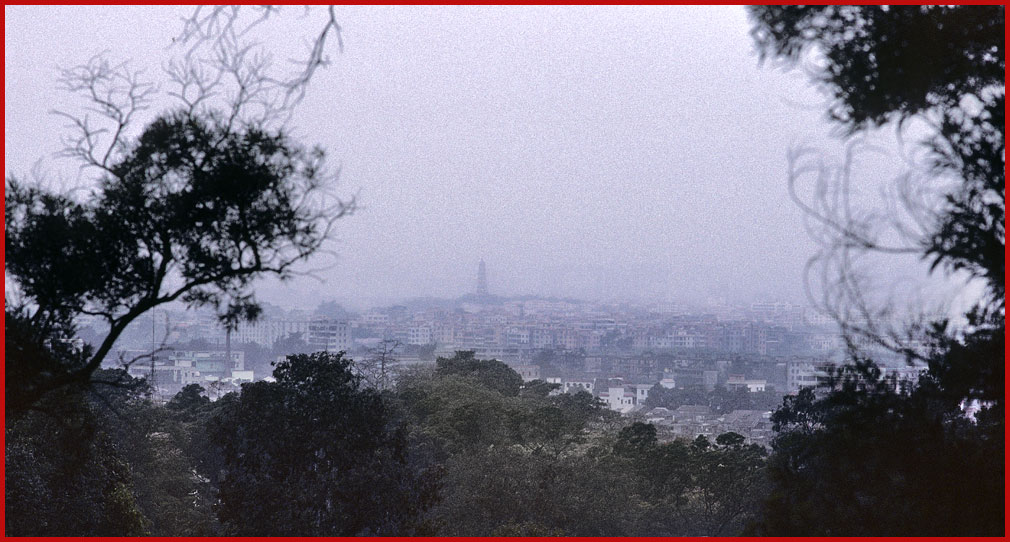
Danes Island
- view from the top towards
Whampoa Island -
The old pagoda can be clearly
seen in the mist!
(Photography by Karsten Petersen)
But the search had to continue
- - - -
The next cemetery we visited
was right at the river bank,- as it was supposed to be -, but it was NOT
on a hill.
Furthermore,- this cemetery
was for Chinese people, and of much newer date than the grave site I was
looking for.
As usual a lot of people gathered
around us, and Xiao Ling tried to make them understand, that I looked for
"Gwei-Lo" graves, - at least 150 years old -, or older - - - -
But nobody seemed to know anything
about
such a place - - - -
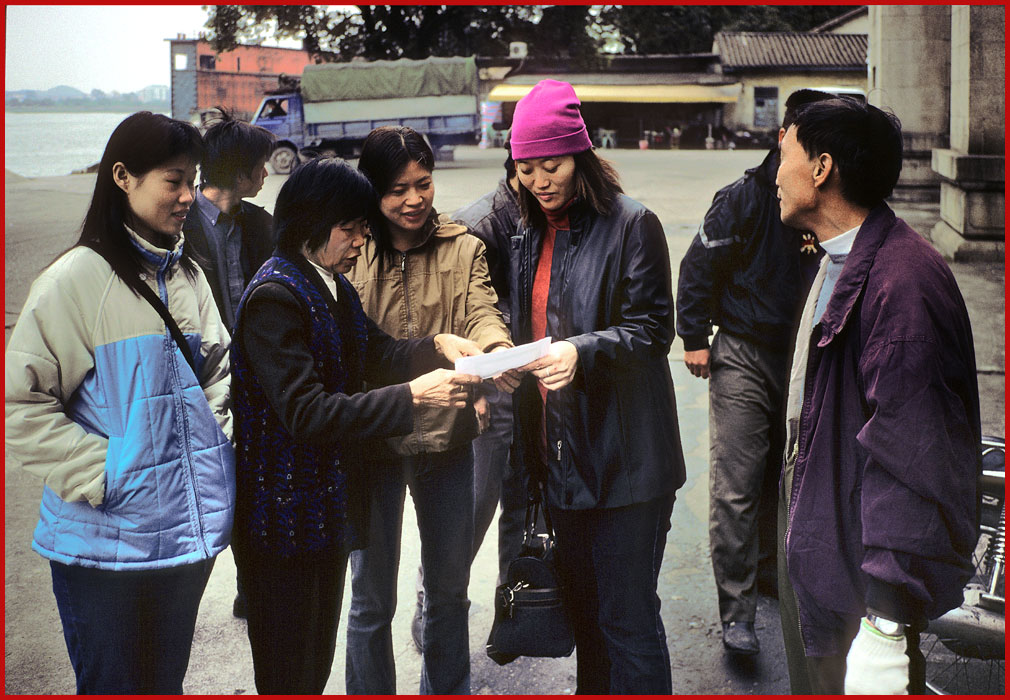
Danes Island
- Xiao Ling trying to
explain to the locals what we were looking for -
(Photography by Karsten Petersen)
At that point I almost gave
up - - - - -
Maybe those old sailor's graves
did not exist anymore????
Maybe the Red Guards had been
there already,- and destroyed everything????
Maybe the old "Cemetery Hill"
had disappeared as well???
In the name of progress, it
could easily have been leveled, and the site used for a shipyard or similar????
But I decided to give it one
more try - - - -
We were now at the bank of
the Pearl River and just across was Whampoa Island, just like on my old
painting - - - -
I HAD to be very near, and
at this point it would be stupid to give up - - - -
And obviously Xiao Ling had
got a hint of something promising.
We were just outside the gate
of a shipyard, and in the guard house outside the yard, there was a watchman
in a small office with a telephone.
Xiao Ling talked to him, and
soon he started to make some telephone calls.
Later Xiao Ling talked in the
telephone as well, - and some of the calls took VERY long time.
What was said,- and with whom
she talked to -, I do not know, but finally she came up with a new clue
to the mystery about the forgotten graves on Dane's Island.

Danes Island
- Xiao Ling on the phone,-
pulling strings in the guard house -
(Photography by Karsten Petersen)
Soon we were on our way again,
- this time accompanied by an official from the ship yard.
Next stage of the search had
begun - - - -
We stopped at another guarded
gate, and again a lot of talking took place and the telephone was glowing!
However, things went very smooth
this time - - - -
The man from the ship yard
obviously had some important position, and after Xiao Ling had signed
a paper in Chinese, we all continued through the gate, now followed by
one more person - - - -
The area inside looked like
a deserted industrial site,- pretty run down and overgrown with grass and
vegetation -, and with rusty bits and pieces of steel scattered in the
grass - - - -
There was forest with huge
trees around the area - - -
Nobody seemed to work there
- - - - it was empty - - - -
We stopped at the end of a dirt
trail - - - -
A small, steep mountain rose
in front of us - - - -
It was heavily covered by big
trees with very dense vegetation below - - - -
One of the "yard men" pointed
to the hill - - - - - - -
"Up there is supposed to be
something - - -", he said.

Danes Island
- up the hill through dense
vegetation - apparently nothing special to see -
(Photography by Karsten Petersen)
I rushed up the hill like a
bulldozer,- fighting my way through the dense vegetation -, making a trail
for the rest of our company - - - -
At this point I was VERY exited,
because this time the place looked right!
It was a hill, and it must
have been very near the Pearl River bank,- and it was opposite Whampoa
Island - - - -
Everything matched perfect
- - - -
But as I worked my way up the
hill I became disappointed again - - - -
Apparently there was NOTHING
here, but I realized, that things could easily be completely hidden in
the very dense, jungle like vegetation,- just a step away from me
- - - -
Only I could not see anything,-
not yet!
But when I came near the top, the dense undergrowth partly disappeared, and made it possible to see much more ahead of me - - - -
And BINGO - - - -
Suddenly I saw a corner of
a stone protruding from the ground - - -
And it was clearly man-made
- - - -
It was winter, and a lot of
the trees had lost their leaves, which now covered everything, but when
sweeping the leaves and earth away from the stone I saw that it also had
traces of writing on it - - -
And further through the vegetation
I saw more,- and more, - and more stones - - - -
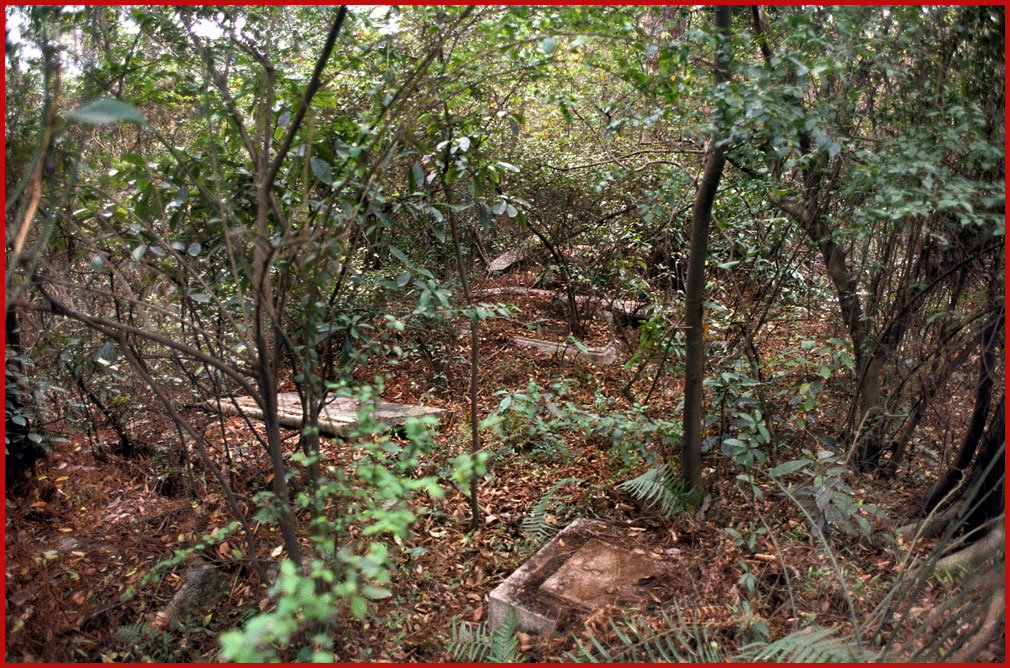
Danes Island
BINGO!! - Old tomb stones
scattered in the forest
(Photography by Karsten Petersen)
The whole mountain top contained
tombs, and by digging them out and cleaning them for earth and leaves it
was possible to read fragments of the inscriptions on several of them -
- - -
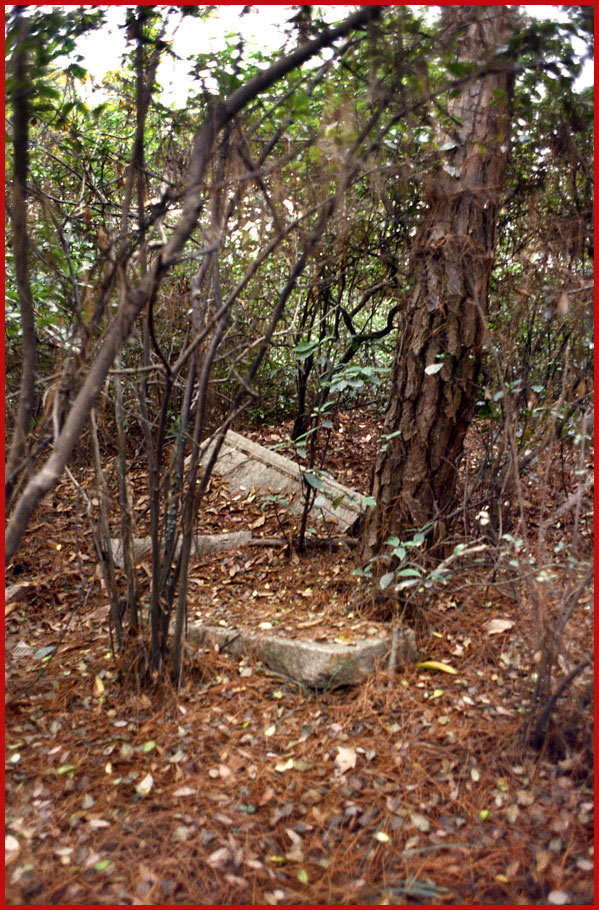
Danes Island
- everywhere, - more and more
stones appearing -
(Photography by Karsten Petersen)
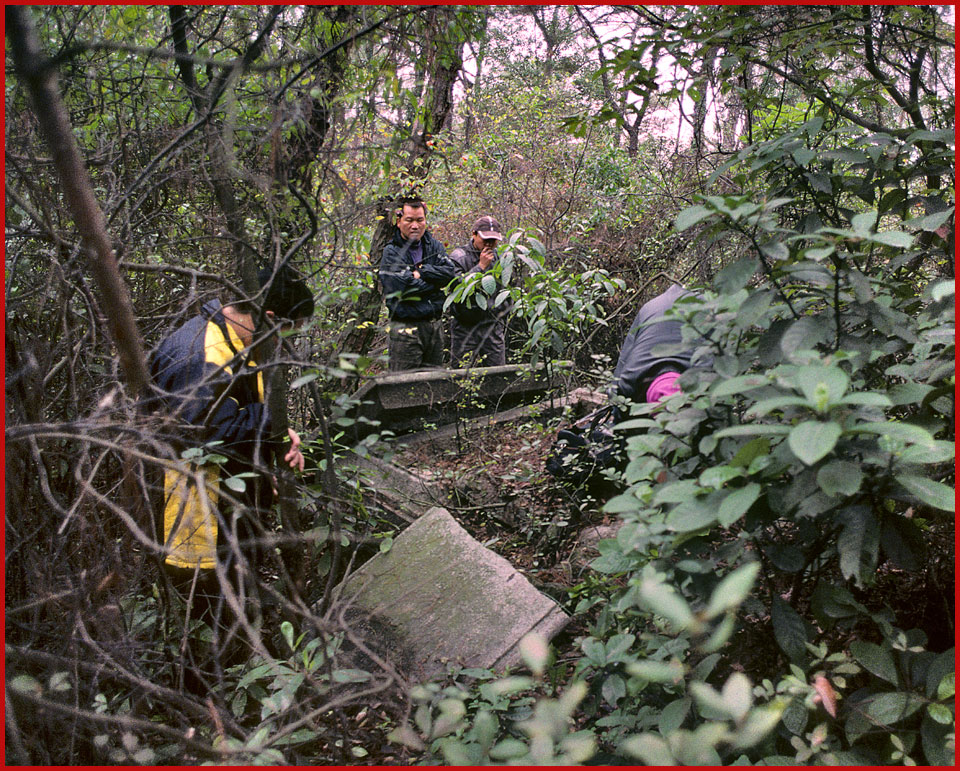
Danes Island
- Tomb "fever" - - -
Not only me, - but all are very exited -
(Photography by Karsten Petersen)
The whole mountain top contained tombs, and cleaned for earth and leaves it was possible to read fragments of the inscriptions on several of them - - - -
I could identify dates, - around
the first half of the 18 hundreds.
Everything fitted in - - -
-
But the names I could identify
were all Indian names, which I found strange, but I concluded that most
likely they had served in the British army, and therefore buried the same
place as the Europeans - - -
But although I searched a big
area, and cleaned lots of stones, I did NOT find any European names on
the tomb stones. However, - I found the word "Parsee" mentioned many times,
and on a lot of the stones there was not only English writing, but also
Indian - - - -
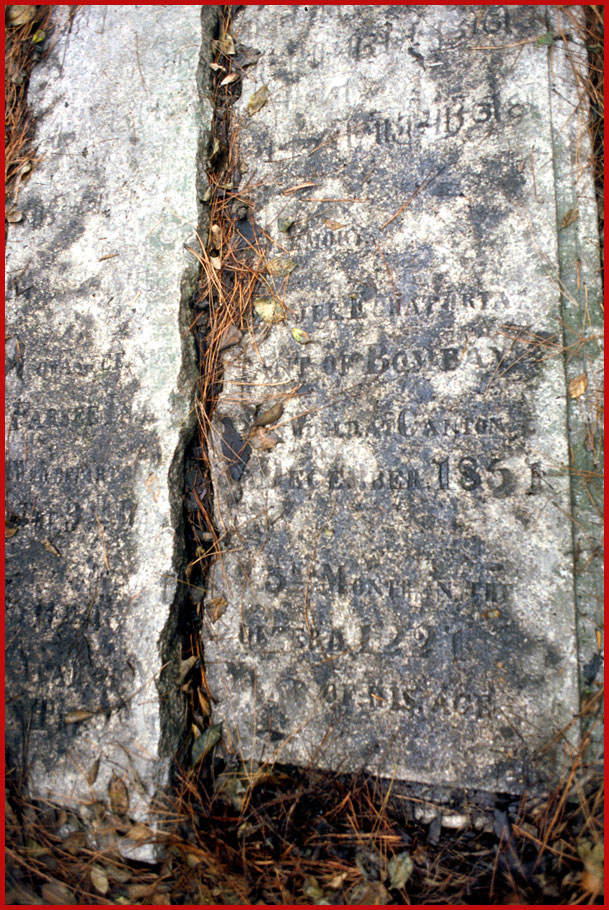
Danes Island
- Parsee tomb stone -
On this stone is clearly marked
the year "1851" , - the word "parsee" and "Bombay", - and it has Indian
writing.
(Photography by Karsten Petersen)
Again I had to accept that also
this cemetery was NOT the one I looked for - - - -
I looked for European sailors
and traders - - -
But very strange indeed, to
find an Indian Parsee graveyard on a remote island in China's Pearl River
delta!
Later I found out that the Parsee
grave site indeed is from the heyday of the China trade.
The Parsees came in from Bombay
and traded with China from Shamian Island, - just like the Europeans -
- - -
However,- the Parsee way of
burying their dead is normally NOT like what you find on Dane's Island.
Actually they do NOT bury their
dead at all - - - -
The bodies are just left in
free air in special Parsee cemeteries, - "Towers of Silence" -, and then
it is left to Mother Nature and the vultures to take care of the rest -
- - -
That brought my thoughts about
25 years back in time, when I happened to be in Bombay, where I one fine
day set out with the purpose to find and photograph the "Towers of Silence"
inside the Parsee cemetery on Malabar Hill - - -.
These "Towers of Silence" are
huge open, round structures that most of all look like forts, but without
guns pointing out from the top of the fortress wall.
Inside these "Towers of Silence"
is where the Parsees dumped their dead, - without burial - - -
However,- my mission failed
miserably!
When I could not charm my way
in through the main gate, I looked for another access, - but no chance!
Foreigners are obviously not
welcome to enter and explore the "Towers of Silence" - - -
Therefore I never saw the "Towers
of Silence", but they were there all right, which was clearly indicated
by the large number of vultures circling the area.
But with the wonders of the
"Google World" satellite map of our wonderful planet, you can actually
have a perfect aerial view of the "Towers of Silence".
Just zoom in at Malabar Hill
in Bombay, - present days Mumbay -, and you see them very well in the jungle
covered area of the hill.
But back to Danes Island in
China's Pearl River delta - - -
Here the Parsees obviously
did not use "Towers of Silence", but quite ordinary cemeteries.
The reason for this is, that
the Chinese authorities did not allow the Parsees to practice their special
burial rites on Chinese territory.
The bodies HAD to be properly
buried, and that explains the Parsee cemetery on Danes Island.
But I looked for the European grave site I had learned about from my old painting, and this was NOT it, although it was indeed a very interesting discovery and a nice extra bonus to get for all my troubles!
We continued our search and
asked several people for help, and we got various suggestions - -
- -
Soon we ended up in another
cemetery, which was clearly an old one, but it was a traditional Chinese
grave site, far from the Pearl River,- and with no European tombs -, but
I got the chance to say "Hello" to the caretaker - - - -

Danes Island
- the caretaker -
(Photography by Karsten Petersen)
Click HERE to continue the search for "The Lost Graves" - -
Click HERE to go back to the "China Menu" - - -
Click HERE to go back to "The China Trade",-3.
Updated: Dec.18.2002
Nov.17.2004
August 01.2006
July 06.2008
July 07.2008
July 14.2008